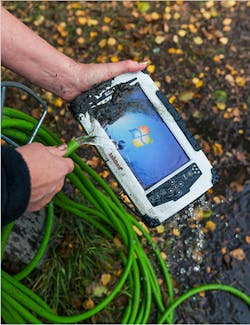Even professional users of rugged laptops, tablets and smartphones are sometimes unsure of what defines a “rugged computer” and how the various tests to validate ruggedness are carried out. A truly rugged computer is so much more than just a normal computer wrapped in a tough outer case.
There’s a difference between “rugged” and “ruggedized.” A rugged computer (or tablet or smartphone) is designed to operate reliably in very harsh environments and conditions. The term “ruggedized” gives the sense that fragile internal components have been somehow protected. Truly rugged devices are not simply wrapped in a tough shell.
Tough and durable mobile computers and smartphones for use in the field are gaining in popularity. Some mainstream devices that could be described as ruggedized (and are often advertised as rugged), but they are not truly so. They might be waterproof, but they lack other aspects of ruggedness, like the ability to withstand vibrations/shocks and to function well in extreme temperatures.
Putting Them to the Test
With a deeper understanding of the standards and the tests, it will be easier to choose the mobile rugged device that suits your unique needs. Truly rugged computers must pass the following tests:
- Drop and shock testing: This is one of the most important tests for rugged computers, simply because rugged computers are dropped all the time. Drop a normal computer and you will easily break the display or the hard drive. Drop a rugged computer and nothing will happen — at least it is highly unlikely that the device will break if it has passed all the relevant tests. All rugged mobile computers are tested to ensure they can survive falls as well as high-force impacts to the devices’ casings. Drop tests are certified by independent test laboratories.
- Liquid resistance testing: Mobile field computers are inevitably exposed to rain, spills and splashes. The second number of the product’s IP code describes the liquid ingress protection — i.e. how well the unit is protected against water. The scale ranges from dripping water to continuous immersion. Water resistance tests are often carried out by the manufacturers of rugged computers by exposing the computer to powerful water jets from many directions without harmful effects. The test duration, water volume and water pressure varies depending on the rating.
- Vibration testing: Ordinary mobile computers are sensitive to vibrations and are not built to handle them. Hard drives disks are especially vulnerable when subjected to vibration. Rugged computers, however, must be able to handle vibrations since they are often used in vehicles that travel on bumpy and rough surfaces.
- Sand and dust testing: A rugged computer must be able to keep out particles. Almost all field workers are exposed to dust and dirt at some point that would slow key functions and damage components if not protected.
- Extreme temperature testing: Rugged mobile computers must be able to handle extreme temperatures and wild temperature swings. When testing for operability during extreme high and low temperatures, the devices are exposed while turned off (storage), while being turned on and used (operation), and how it works under operational temperatures after having been exposed to high/low storage temperatures (tactical-standby to operational).
- Humidity testing: In addition to liquid resistance testing for IP rating, many manufacturers of rugged mobile computers test their devices in highly humid conditions as a separate test. The computers are exposed to humidity well over 90 percent for several days in tropical heat. Many of the same features that make mobile computers liquid resistant also help prevent damage from high humidity.
How They are Made
How do manufacturers of rugged mobile computers actually make their devices touch enough to pass these tests?
As opposed to normal computers, most rugged computers have no moving parts inside, like fans or rotating hard drives. Instead of rotating hard drives, rugged computers have solid-state drives that do not have moving mechanical components and are more resistant to physical shock.
There are stiffeners inside a rugged computer, often made out of aluminium, to prevent inside components and boards from flexing during an impact. The outer shell (case) is designed to absorb the energy from a drop to prevent internal damage.
The touchscreen of a normal smartphone or computer is basically glass (with some coating to make them sensitive to touch), whereas the displays of rugged computers use chemically strengthened glass to prevent against scratches and cracks. The displays can also be positioned lower than then surrounding case to decrease their vulnerabilty.
Display backlight is used to improve outdoor readability, even in direct sunlight.
Some rugged computers are fitted with internal heaters in order to operate successfully in very cold environments. The heater warms components to an acceptable operating level and eliminates condensation arising from temperature swings.
Jerker Hellström is the CEO of Handheld Group (www.handheldgroup.com).


